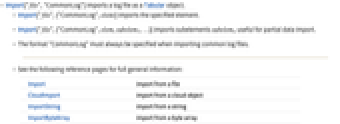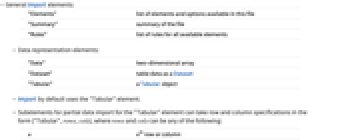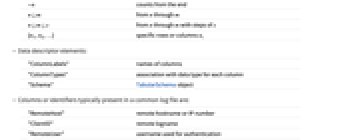CommonLog
Background & Context
-
- Common Log Format.
- Also known as NCSA Common Log Format.
- Used for logging web traffic.
- Plain text format.
- Represents each record as a line of text.
- Developed by NCSA.
Import

- Import["file","CommonLog"] imports a log file as a Tabular object.
- Import["file",{"CommonLog",elem}] imports the specified element.
- Import["file",{"CommonLog",elem,subelem1,…}] imports subelements subelemi, useful for partial data import.
- The format "CommonLog" must always be specified when importing common log files.
- See the following reference pages for full general information:
-
Import import from a file CloudImport import from a cloud object ImportString import from a string ImportByteArray import from a byte array
Import Elements


- General Import elements:
-
"Elements" list of elements and options available in this file "Summary" summary of the file "Rules" list of rules for all available elements - Data representation elements:
-
"Data" two-dimensional array "Dataset" table data as a Dataset "Tabular" a Tabular object - Import by default uses the "Tabular" element.
- Subelements for partial data import for the "Tabular" element can take row and column specifications in the form {"Tabular",rows,cols}, where rows and cols can be any of the following:
-
n nth row or column -n counts from the end n;;m from n through m n;;m;;s from n through m with steps of s {n1,n2,…} specific rows or columns ni - Data descriptor elements:
-
"ColumnLabels" names of columns "ColumnTypes" association with data type for each column "Schema" TabularSchema object - Columns or identifiers typically present in a common log file are:
-
"RemoteHost" remote hostname or IP number "ClientID" remote logname "RemoteUser" username used for authentication "Date" date and time of the request "RequestLine" request as given by the client "StatusCode" the HTTP status code returned to the client "ByteCount" byte size of the tranferred document - Metadata elements:
-
"ColumnCount" number of columns stored in file "Dimensions" data dimensions "RowCount" number of rows stored in file
Import Options
- General Import options:
-
"Schema" Automatic schema used to construct Tabular object - Possible settings for the "Schema" option include:
-
schema a complete TabularSchema specification propval a schema property and value (see reference page for TabularSchema) <|"prop1"val1,…|> an association of schema properties and values
Examples
open all close allBasic Examples (2)
Import Elements (20)
"Data" (6)
"Dataset" (1)
Import a log file as a Dataset:
"Schema" (1)
Get the TabularSchema object:
"Tabular" (6)
Import a log file as a Tabular object:
Import Options (2)
"Schema" (2)
Import automatically infers column labels and types from data stored in a log file:
Related Guides
History
Introduced in 2025 (14.3)